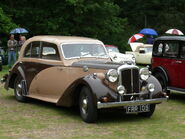 | |
| Manufacturer | The Daimler Motor Company Limited |
|---|---|
| Parent company | BSA |
| Also called |
Daimler Eighteen (1939–1950) Daimler 2½-litre (1939–1950) Daimler Consort (1949–1953) |
| Production | 1939–1953 |
| Predecessor | Daimler New Fifteen |
| Successor | Daimler Conquest |
| Body style(s) |
four-door saloon numerous coachbuilt versions, standard catalogued models by Daimler subsidiaries Hooper (formal) and Barker (drophead coupés), others as arranged with coachbuilder by customer [1] |
| Layout | FR layout |
| Engine(s) | 2,522 cc 6-cylinder in-line ohv [1] |
| Transmission(s) |
4-speed preselective self-changing gearbox and Fluid Flywheel an open propellor shaft and underhung worm-driven axle, hypoid bevel from June 1950 Overdrive on Special Sports |
| Wheelbase | 114 in (2,900 mm)[1] |
| Length |
180 in (4,600 mm) (2½-litre)[2] 180 in (4,600 mm) (Consort)[1] |
| Width | 65 in (1,700 mm)[2] |
| Height | 63 in (1,600 mm) [2] |
| Fuel capacity | 14 imp gal (64 L/17 US gal)[2] |
| Manufacturer | The Daimler Motor Company |
|---|---|
| Production | September 1938 - 1953 introduced in Daimler Fifteen |
| Predecessor | Daimler Fifteen 2.2-litre |
| Successor | Daimler Conquest 2½-litre |
| Configuration | 6-cylinder in-line |
| Displacement | 2,522 cubic centimetres (154 cu in) |
| Cylinder bore | 69.6 mm (2.74 in) |
| Piston stroke | 110.49 mm (4.350 in) |
| Cylinder block alloy | cast iron, aluminium alloy pistons |
| Cylinder head alloy | detachable |
| Valvetrain | OHV, pushrod cam-in-block (and from 1946) valves canted 15 degrees in special combustion chambers |
| Compression ratio | 7:1 |
| Fuel system |
Horizontal S.U. carburettor AC mechanical fuel pump dual carburettors on Special Sports |
| Fuel type | petrol |
| Oil system | gear pump 40 lb pressure |
| Cooling system | water-cooled thermostatically controlled, centrifugal pump and 4-blade fan |
| Power output |
from 1946 70 bhp (52 kW/71 PS) @ 4000 rpm. Tax rating 18.02 hp |
The Daimler Eighteen or Daimler DB18, a 2½-litre version of the preceding 2.2-litre New Fifteen introduced in 1937 now using the engine developed for the Scout Car,[3] started out in 1937 as a six-cylinder chassis on which Daimler and various British coach builders offered a range of bodies including drop-head coupes. However, the most common version was a four-door saloon which Daimler themselves produced and which by the early 1950s was beginning to look unfashionably upright and “severe yet dignified”.[2]
The model was introduced immediately before the start, for Britain, of the Second World War when the company concentrated on the manufacture of military vehicles. Most DB18s were produced after 1945, therefore. To contemporaries the model was generally known as the Daimler 2½-litre until Daimler adopted the North American habit of giving their cars names (although not on any badgework), and a slightly updated version of the car was introduced in October 1948 at the London Motor Show, "principally for export" and branded as the Daimler Consort.[4] The updates included the integration of the firewall into the body rather than it being part of the chassis, a move from rod operated mechanical brakes to a Girling-Bendix hydraulic front and rod operated rear system, incorporating the head lights into the front guards, and providing a badge plate behind the front bumper with a more curved radiator grille.
The car used a 2,522 cc in-line six-cylinder, pushrod ohv engine fed by a single SU carburetter.[2] Throughout its life, 70 bhp was claimed, though a change in the gearing in 1950 was marked by an increase in maximum speed from 76 mph (122 km/h) to 82 mph (132 km/h) for the saloon, while the acceleration time from 0 – 50 mph (80 km/h) improved from 17.9 to 16.9 seconds.[1] By the standards of the time the car was brisker than it looked.[2]
The car was supplied with the Daimler Fluid Flywheel coupled to a 4-speed Wilson Pre-selector gearbox. The independent front suspension used coil springs, while the back axle was suspended using a traditional semi-elliptical set-up.[2] The chassis was "underslung" at the rear with the main chassis members passing below the rear axle. In mid-1950 the restricted ground clearance was improved by the adoption of a conventional hypoid bevel drive to the rear axle replacing the traditional Daimler underslung worm drive which had hampered sales outside Britain.[5]
The interior was fitted out with traditional “good taste” using mat leather and polished wood fillets.[2]
Sales levels were respectable: 3,355 Daimler 2½-litres were produced and 4,250 Consorts
References[]
| This page uses some content from Wikipedia. The original article was at Daimler Consort. The list of authors can be seen in the page history. As with Tractor & Construction Plant Wiki, the text of Wikipedia is available under the Creative Commons by Attribution License and/or GNU Free Documentation License. Please check page history for when the original article was copied to Wikia |
- ↑ 1.0 1.1 1.2 1.3 1.4 Culshaw; Horrobin (1974). Complete Catalogue of British Cars. London: Macmillan. ISBN 0-333-16689-2.
- ↑ 2.0 2.1 2.2 2.3 2.4 2.5 2.6 2.7 2.8 "Second Hand car guide supplement", Practical Motorist 6(68): 768–769. April 1960.
- ↑ Lord Montagu and David Burgess-Wise Daimler Century ; Stephens 1995 ISBN 1-85260-494-8
- ↑ "2½-litre Daimler Consort saloon", Autocar. September 9, 1949.
- ↑ Display advertisement, The Times, Thursday, Jun 15, 1950; pg. 8; Issue 51718
This entry includes statistical information from the German Wikipedia concerning the Daimler Motor Company.






